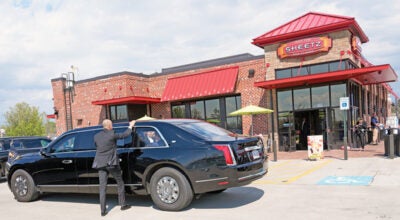D-B students take top essay honors
Published 9:59 am Tuesday, December 27, 2011
Recently students of Lori Deer’s class at Dawson-Bryant Elementary School took top honors in the history essay contest sponsored by the Lawrence County Historical Society.
Winners were chosen by a panel of outside judges.
In first place was Jasson Aguilera who received $50 prize money; Mikayla Daniels in second place with the $25 prize; and Nathan Davis in third place with $10 prize.
Jasson Aguilera – first place
The strange story of Dr. Lowry: A ghost whose actions came back to haunt him.
Ohio Doctor’s mortician had the last word in an argument.
This is a ghost story.. Well kind of, it’s also a tale to be careful on who you argue with in life, because that person can come back to haunt you when he/she dies.
Our story starts near where I live, in Ironton, Ohio, with a dead doctor, missing organs, and a murder investigation.
At that time that that happened Ironton, Ohio, was to America what Silicon Valley is now: the heart of successful business that supplied the world with needed goods. From 1850-1890, countries such as England, France, and Russia bought iron rocks. This iron was shipped through the river port town of Ironton.
It is shortly after this prosperous time that our story is set. People started to say that the spirit of Dr. Joseph W. Lowry haunts Briggs Lawrence County public Library. The library is built on the site of Lowry’s old home.
Is the library haunted? It’s hard to say. In 2000 the library staff was questioned about Dr. Lowry. They said that he kept them all busy by rattling keys, closing doors and playing with the computerized card catalog.
All these things sounded too nice for a spirit like the one of Dr. Lowry, especially for someone knows his story..
Let me tell you a little bit about him..
Dr. Lowry was a very respected physician who worked in Ironton his entire life. However, this respected physician had a questionable reputation in the local courts.
According to the Ironton Register, in June of 1896, Dr.. Lowry sued the Ironton Board of Health for $500 for services throughout the previous year as a city medical examiner. The city council refused to pay the bill, saying it was illegal.
Dr. Lowry was again in court in February of 1899.
This time the doctor was being formally charged for making false statements as a medical examiner.
But whatever Dr. Lowry’s character, the story actually begins in 1931, when Lowry’s wife died.
It’s said that the grieving doctor ordered a specially made casket for his petite wife.
That’s when the trouble started. When the casket arrived, Dr. Lowry was unhappy with it (or perhaps with the bill), and refused to have his wife buried in it, or even to pay for it. Instead he made the mortician responsible for the bill of the expensive casket.
It was not a problem for the mortician. After all sooner or later Dr. Lowry would need his services again. At that point, all bills would come home to pile up.
As expected, the mortician didn’t have to wait too long. Barely two years later, Dr. Lowry passed away under suspicious circumstances. He was found in bed at home, in the middle of summer, with his heat turned on.
Suspicion fell on Dr. Lowry’s heirs, but the case was in the end considered as a stroke and the doctor’s remains were taken to the mortician.
This was the moment that the clever mortician waited for. Not only could he settle his old grudge with the good doctor, but he could also get back all that money that Dr. Lowry had cheated him out of two years prior.. He would simply bury the doctor in the casket, and charge the bill to his estate.
If the doctor was too tall for the specially made casket, well he wouldn’t exactly need his legs, would he?
And if he was too fat for the lid to close, he wasn’t using those internal organs, anyway.
The mortician would have gotten away with it too, if not for the growing suspicion that Dr. Lowry’s heirs had offered the old man for his money. An investigation soon followed, and when the authorities took the body out of the tomb, the mortician had quite a few disturbing questions to answer like why
Dr. Lowry’s legs were broken? And while we’re on the subject, where were his organs?
Unfortunately for Dr. Lowry, (or perhaps fortunately for his heirs), by the time the mortician led the authorities to the place where he had hidden the doctor’s internal remains, they were so badly decomposed that they could not be tested for signs of poison.
These days, it’s said that Dr.. Lowry wanders about the halls of the library and Woodland Cemetery searching for his missing organs and possibly regretting that he got on the wrong side of the one man who could get the last word in the argument.
“The Life of John Campbell”
By Nathan Davis Third place
John Campbell, the founder of Ironton, was born on Jan. 14, 1808 in Georgetown, Ohio.
Having no formal education, he learned how to be a good businessman by working on his father’s farm, and at his first job at a general store in Russellville, Ohio. At the young age of 20, he saved $600 and bought part interest in a steamboat named “Banner. Soon after, he took a business trip to Pittsburgh and met Robert Hamilton of Hanging Rock, and they became close friends. In the early 1830’s Campbell and Hamilton became identified with the iron interests of the Hanging Rock Region. In 1832, Campbell partnered with another businessman named Andres Ellison. They built the Lawrence Furnace for J. Riggs and Company.
In 1834, along with his good friend Robert Hamilton, he built the Mt. Vernon Furnace. In 1837, Campbell obtained an interest in the Vesuvius Furnace also located in the region.
This was also the year he married Elizabeth Caldwell Carter, who just happened to be the niece of his friend Robert Hamilton. They had first met in Ripley when she attended a seminary conducted there by Rev. John Rankin. She had lived in Manchester and in Hanging Rock at the home of her uncle Robert. They were married at Pine Grove Furnace on March 16, 1837, by Rev. Dan Young. They had seven children: Mary Jane, Martha Elizabeth, Emma, Clara, Albert, Charles and another child who died in infancy.
Several years later he joined another businessman by the name of John Peters and built the Greenup Furnace in 1844. They also built the Olive and Buckhorn Furnace in Ohio two years later. The Gallia Furnace was built by Campbell in 1847, and along with others he also built the Keystone Furnace in 1849. This was an important year for John Campbell. He organized the Ohio Iron and Coal Company, which purchased 400 acres of land four miles above Hanging Rock to build a town. He wanted a name for the town to suggest the business of the new city, thus naming it “Iron-Town” or Ironton. In 1850, Campbell moved from Hanging Rock to Ironton. His home was built at Fifth and Lawrence in 1850 and occupied in 1851.
John Campbell was well known as a strong abolitionist. He withdrew from the Democratic Party in 1848 over the issue of slavery. For years afterward, Campbell used his home, barns, furnaces and wagons as stops and transportation for slaves traveling from Kentucky to Ohio on the Underground Railroad.
In 1850, Campbell purchased the LaGrange Furnace and built the foundry of Campbell,
Ellison and Company. In the following year, Campbell became a city councilman. In 1852, he was one of the organizers of the Ironton Rolling Mill, and he bought the Hecla Furnace. Mr. Campbell built the Madison Furnace in 1854, and with the help of others, also built the Howard Furnace. Soon after, Campbell entered into the steel beam plow business and bought stock in the Star Nail Mill. In 1866, he organized the Union Iron Company, which owned the Washington and Monroe furnaces.
Even in his later years, John Campbell was a community leader. In 1862, Mr. Campbell was appointed by President Lincoln as the first Internal Revenue Collector for the 11th Collection District of Ohio. By 1872, he had become a self-made millionaire. Unfortunately, during the panic of 1873 he lost most of his fortune.
John Campbell, who loved civil and religious liberty, died of uremic poisoning on Aug. 30, 1891, at the age of 83. All the businesses closed in Ironton on the day of his funeral. It was held at his home on Sept. 1, 1891. Over 1,000 people paid their respects and 60 carriages were in the procession. He was buried in Woodland Cemetery in Ironton, Ohio where he remains today. After the death of Mr. Campbell, the home was purchased by the Murdock family, who lived there for a number of years. It was then purchased by Bingaman-Jones for a funeral home in 1930. In the mid 1940’s, the home was purchased by William and Mildred Baker and was known as the Baker Funeral Home. On July 19, 1975, the Ironton Lawrence County Community Action Organization purchased the building and renamed it the John Campbell Memorial Home.
References: Woodland Cemetery Historic Ghost Walk Reference Book. Briggs Library, Ironton, Ohio: Lawrence County Historical Society.
Statue Of Osa Wilson
By Mikayla Daniels – 2nd place
There is a statue of Osa Drummond Wilson in the Woodland Cemetery. Some people have questioned whether the legend of her death is true or just rumors. Her statue has been in the Woodland Cemetery for almost 100 years, and is considered to be one of the most mysterious and most beautiful statues in the cemetery. As beautiful as the statue may be, it has been a tragic story that haunts the minds of our area and makes all of us wonder, What happened to Osa Wilson and how did she become known as the “Slapped Lady?”
Osa Drummond Wilson was born in April 1877, in Gallia County. She was the daughter of James to Drummond and Missouri Neal. On Sept. 12 1894 she married Scott William Wilson, an insurance agent who worked out of their home at 130 Chestnut St. in Ironton. Some said Mr. Wilson was a very good husband, but the story commonly says that her husband was verbally and physically abusive towards her.
According to legend Mr. Scott Wilson arrived home one evening and an argument broke out. Out of anger he allegedly slapped Osa across the face and caused her to fall down a flight of stairs. The injuries that occurred on Jan. 26, 1911, ultimately led to the death of Osa and her unborn baby on Feb. 25, 1911, about a month after her fall. There were no public records of Scott Wilson being part of her death, however it was a different time when domestic violencewas often considered a normal behavior and allowed and overlooked.
Osa’s death notice stated “The spirit of Mrs. Scott Wilson was called from the weary struggles of the world to receive its heavenly reward early Saturday morning after four weeks due of illness from a complication of diseases.
“Her life can be well-cited as an example of the highest type of home-loving wife and mother, Her loss is almost unbearable to her sorrowing husband and the six little children who have lost their best earthly friend.”
Her death certificate says her cause of death was neuritis with colitis. Neuritis is inflammation of a nerve or a number of nerves, maybe from a fall. Nobody really knows, but some believe Osa’s statue is still trying to tell her story.
If you stand in front of her statue you can see her cheek isn’t the same. It is said that the closer you look there is a visible red mark resembling a hand print. Several attempts have been made to remove it by sandblasting it and repair it, but the handprint returns. Legend also states that the statue cries real tears and even it the coldest winters you can feel her unborn baby’s heartbeat and warmth from her belly.
While her husband was never convicted of her death, he stated that the statue was to be made as a tribute of his undying love. Some say it was created to brag about him getting away with her murder. A little over a year after Osa’s death, Scott remarried Lou Price Wilson. The truth may never be known. All that remains is that statue and a legend of a woman whose whole life ended in tragedy.





